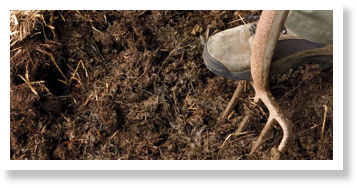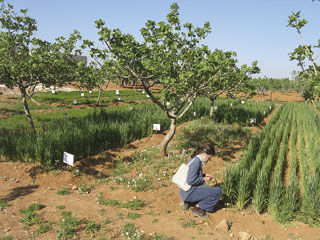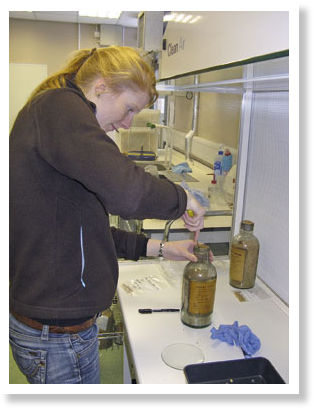
© Unknown
As any gardener knows, animal manure does a brilliant job of keeping soils rich in nutrients and easy to work. Though chemical fertilizers are now widely used, manuring still plays a critical role in food production in many parts of the world today. But was it always so important?
The Crop Isotope Project is the first attempt to systematically assess the importance of manuring in early farming communities, dating back thousands of years - and the results have been, well, ground-breaking.
Archaeologists know where and when the 'ingredients' of European farming emerged - around 10,500 years ago in the Middle East's Fertile Crescent - and we have a good grasp of how agriculture then spread into Europe. But what was early farming like? How were crops grown and animals raised? This kind of understanding is crucial for explaining how farming emerged and became established, as well as its long-term consequences.
In the Middle East, growing crops and herding animals emerged at around the same time. Furthermore, the early suite of crops and livestock (wheat and barley, pulses and flax, together with sheep, goats, pigs and cattle) went on to spread together across Europe. This combined crop-and-livestock 'package' hints at some sort of mixed farming.
The spread of muck-spreadingLooking at how modern small-scale farmers do things shows that cultivation and herding can be mutually beneficial: crops supplement the animal diet, for example, while livestock provide manure, disturb the soil and regulate crop growth. Importantly, manure has a 'slow-release' effect on soils and can be beneficial for years or even decades after application; it implies long-term commitment to cultivated areas.
This kind of long-term investment is at odds with the idea that early European farmers were slash-and-burn cultivators. The analogy with this form of farming, best known today in tropical latitudes, is problematic at best, but it lingers in the archaeological literature and popular imagination. If, instead, early farmers maintained arable land through manuring and other intensive practices, the implications for our understanding of their daily life, material culture and monuments are radical.

© UnknownThe author at an experimental site near Aleppo, Syria.
The image of early farmers carefully tending long-established gardens and fields brings into focus a world-view that gave rise both to spectacular statements of permanence and ancestral rights - such as British and Irish megalithic tombs - but also to brutal conflict. This is reflected, for example, in the 'mass grave' of an early farming community at Talheim in Germany, killed by assailants wielding stone axes like those used to clear farmland.
To assess the relevance and extent of manuring among early farmers, we needed to learn to identify it archaeologically. Agricultural soils are rarely preserved, so the primary evidence for ancient cultivation comes from crop remains - grains and inedible plant parts ('chaff') preserved mostly through charring, which renders the material biologically inert but preserves its shape.
Food science, a discipline far removed from archaeology, provided the key clue: an approach used to authenticate organic produce! Previous research showed that mineral fertilizer and farmyard manure have different effects on which forms of nitrogen get incorporated into the soil and taken up by crops.
Nitrogen comes in different forms, called 'isotopes'. Mineral nitrogen is rich in the lighter stable isotope (14N), whereas farmyard manure has more of the heavier form (15N). Food scientists use this contrast to identify fertilizers applied to vegetables, to ensure that only 'organic' manures were used on produce that's labelled organic.
We focused on seed crops grown by farmers of the Neolithic and the Bronze Age periods - and on how manuring affected their isotope ratios. To assess these relationships, we collected modern crop material from experimental stations across Europe, including Rothamsted in Hertfordshire, set up our own experiments - at Sutton Bonington near Nottingham and in Syria, near Aleppo - and visited regions where crops are still grown in traditional ways, including Asturias in Spain, Transylvania in Romania and Evvia in Greece.
Grains of truthOur results left no doubt. Intensive manuring has a dramatic effect on nitrogen isotope signatures in both grain and chaff of wheat and barley; moderate manuring has a correspondingly modest effect. This means we can tell how much manure was applied, if any, from nitrogen isotopes in cereals. Pulses like peas and lentils work differently: they fix nitrogen from the atmosphere, so manuring has a comparatively slight impact on their isotope ratios.
Since crop material is mostly preserved by charring, a further challenge was to establish how this affects nitrogen isotopes. By experimentally charring and then burying modern cereals and pulses, we have found that the effect is modest and predictable. Finally, to remove contamination in ancient crop material introduced over thousands of years in the soil, we adapted methods used to clean charred plant material before radiocarbon dating.

© UnknownAmy Styring sampling crops at Rothamsted.
All this set the stage for assessing archaeological crop material. As the results have rolled in, our excitement has grown: archaeological site after archaeological site returned results showing the pervasiveness of manuring in Neolithic farming communities as well as in later, often much more complex, Bronze Age societies.
In prehistory, as today, manure was in short supply, so it had to be used strategically where it could yield the greatest benefit. Unsurprisingly, therefore, the signals we observe are variable - even, for example, in crops that were harvested in a single year before being destroyed by a catastrophic fire in the storehouse of a Bronze Age community in northern Greece. In fact, there's as much variation as we saw in the villages where we sampled modern crops.
Our results suggest that, while early farming practice was geared towards sustainability, the 'long-term investment' of manuring encouraged families to claim ownership of land, with social consequences culminating in the fixed inequalities of some hierarchical Bronze Age societies.
The story doesn't end there. The very isotope ratios in crops that are affected by manuring will, in turn, affect the long-term formation of nitrogen isotope signatures in the tissues of human and animals that eat them. Stable nitrogen (along with carbon) isotope ratios are routinely extracted from ancient bone to determine the nature of the diet.
Particularly relevant here, differences in nitrogen isotope ratios between humans and associated animal remains are generally interpreted as evidence of their relative position in the food chain - the heavier (15N) isotope gets more common as you move up from prey to predators. The plants people eat, and their livestock or hunted prey, are normally assumed to be isotopically identical, but our modern crop results suggest this is unlikely, for two reasons.
First, manuring creates a disparity between the nitrogen isotopes of crops and those of unmanured wild vegetation. Second, we found systematic differences in isotope values between grain and chaff and other plant parts, which are inedible to humans but can be fed to livestock.
In fact, people and livestock feeding on the same cereal crops but consuming grain and chaff, respectively, would seem to sit around one step apart in the food chain, the grain giving the humans who eat it higher 15N values.
Isotopic analysis of archaeological plant remains alongside those of humans and animals would let us reconstruct ancient diets much more reliably. To do this, we are working to integrate botanical, animal and human isotope values from selected archaeological sites.
We have already discovered that early farmers 'invested' in their plots through manuring. This technologically simple but labour-intensive practice bound cultivation and herding together in resilient forms of small-scale mixed farming. This sustainable kind of agriculture made possible the decisive and irrevocable shift away from hunting and gathering.
By the end of our project, we hope to have transformed our understanding of how our ancestors farmed, ate and lived. But there's still a huge amount to learn about early farming and the role of manuring. Can we discern distinctive regional trajectories in the way agriculture interacted with ecological and social factors over the long term? Were early elites linked with change in agricultural techniques or was there a continuing reliance on small-scale mixed farming, including manuring? We now have the 'toolkit' of methods to find out.
Comment: Research into how our ancestors farmed, ate and lived is admirable, but the fact of the matter is that the advent of agriculture was also the advent of the decline of the human race. The growing of grains and fruits over large tracts of land has not only destroyed much of our environment, but it has wreaked havoc with human health.
For 99% of human history, human beings have eaten animal meat and fat. It is only within the last 10,000 years, with the introduction of agriculture, that humans have eaten grains. We, as a species therefore, are genetically pre-disposed to thrive on animal products. In addition, most grains contain gluten and lectins, the former being a sugar to which many people are allergic, and the latter being a plant's natural defence against being eaten. Lectins are 'anti-nutrients' that damage and impair the function of the intestines of any animal that eat them, including humans. Both gluten and lectins have been linked to a host of 'modern' illnesses that have impoverished the lives of humanity as a whole.